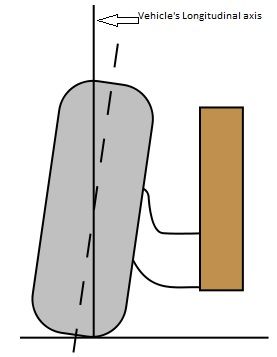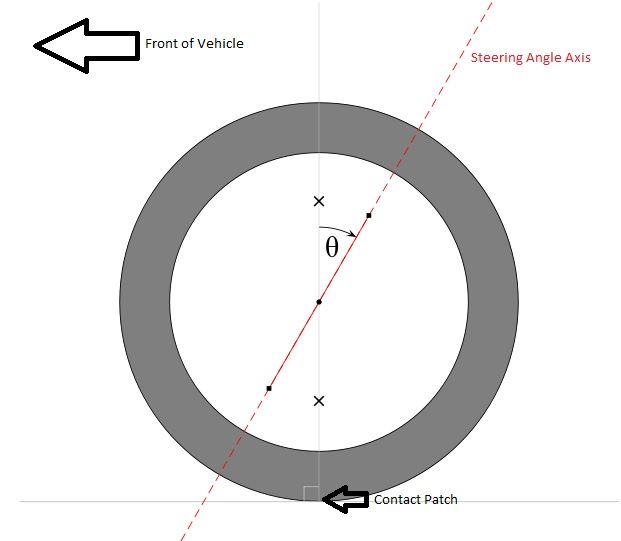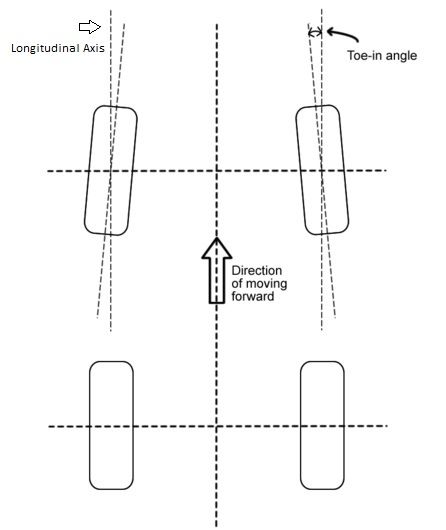Understanding Camber, Castor & Toe
#1
Waking up before the sun rises on the weekend to be at the track, is not what most people think about when they are looking forward to the weekend, but if you are a racer you are counting down the minutes before the weekend. Whether you are competing in the grassroots level or in the professional level, there are three basic parameters that help a driver make up time when he/ she is on the track searching for a fast lap. In this article I will go thru the positives and negatives, with no pun intended, of adjusting camber, castor, and toe and how they could affect the handling of your vehicle.
Camber angle is known as the difference in angle between the longitudinal axis of the wheel compared to the longitudinal axis of the vehicle, in lamest terms it is the overall amount in degrees that the tire will lean in or out towards the chassis. Positive camber is when the top of the wheel is further away from the axle than the bottom of the wheel and negative camber is when the top of the wheel is closer to the axle than the bottom of the wheel. The build of your vehicle and the different arrangement of corners at the track that you are competing in, will help in determining the correct amount of camber that you will need.

Let’s take a 350Z that has a static camber of -2.00 degrees in the front tires while it is going around a corner and examine what the tires are actually doing. The vehicle’s camber will fluctuate as it travels around the track but for this example we have noted that this vehicle has this static camber value. As the vehicle is traveling down the front stretch of the track and is slowing down to enter a right hand corner, the body of the vehicle will begin to roll towards the left side. As the vehicle begins to roll over towards the left side, the weight distribution of the vehicle has now shifted and created a moment about the center of the car. When the weight distribution begins to shift due to the centrifugal forces created when entering a turn at speed, the driver’s side tire will begin to roll over and thus increase the contact patch of the tire. The overall goal is to get the entire surface of the tire to make contact with the tarmac at the center of the apex which will allow the tire to help in getting the vehicle to turn thru this corner. There are a lot of unknowns about this vehicle that we are talking about that we have assumed a constant value for that will affect how much overall camber that will be needed to allow for the entire width of the tire to make contact with the tarmac. If there is not enough camber set in the tire, the vehicle will experience jacking forces as it is traveling thru the corner. Jacking forces will occur when the camber of the tire is set too low, which will make the tire roll over onto its sidewall and very difficult for the driver to turn thru the corner.
Circle track vehicles and road course vehicles will use different configurations of camber settings since the tracks that they will be competing on have different layouts. Road course vehicles will have a symmetrical setup as far as camber where both front tires will have very similar values. Circle track vehicles will have an asymmetrical setup as the passenger side tire will have a negative camber value and the driver’s side will have a positive camber value. The reason why circle track vehicles have this configuration is that they are traveling thru a corner for a longer period of time and at a higher speed which in turn means both front tires need to create the largest possible contact patch to aid with the handling of the vehicle thru the corner. Camber is a very powerful parameter when it comes to setting up your vehicle for the track and testing will need to be conducted to determine the correct amount of camber that you will need to aid you thru your corners.
When it comes to setting up your vehicle, using the correct amount of caster will make turning a whole lot easier for the driver. Caster angle is described as the location of the steering angle axis with respect to the tire’s contact patch. If the top of the steering angle axis is tilted towards the rear of the vehicle, the axis of rotation is in front of the tire’s contact patch, which is known as positive caster. If the top of the steering angle axis is tilted towards the front of the vehicle, the axis of rotation is behind the tire’s contact patch, which is known as negative caster. With positive caster, a torque is created with the location of the axis of rotation and the tire’s contact patch that makes the steering wheel want to straighten itself out easier after you make a turn.

The best way to understand caster is to imagine the front wheels on a shopping cart and how they operate when you are pushing the cart. The front wheels on a shopping cart have positive caster which means that the wheels are going to follow the direction that the shopping cart is being pushed. To understand caster on a vehicle better, take a vehicle that is stationary and turn the steering wheel to the left. As you turn the steering wheel to the left, if the vehicle has a reasonable amount of castor (most vehicles will have around 7 to 8 degrees of positive caster) you will see that the right side of the vehicle will drop in height and the left side will rise. This is due to the fact that the axis of rotation is in front of the tires’ contact patch which in turn will lower the height of the vehicle because the tires contact patch is trailing. Positive caster is important for a track vehicle or any vehicle that is being setup for stability because positive caster allows for self centering of the wheel and weight transfer onto the outer wheel while in a corner.
The final parameter that has a large impact on the way that a vehicle is setup is known as toe which is described as the angle that each wheel makes with the longitudinal axis of the vehicle. Negative toe (toe out) is when the front of the tire is pointed away from the longitudinal axis of the vehicle and positive toe (toe in) is when the front of the tire is pointed in from the longitudinal axis of the vehicle. When we are setting up a vehicle for the track we will set the front wheels up to have an overall toe out and the rear wheels to have an overall toe in. The reason why we have the front tires set up with toe out is because it slightly orients the tire in the direction of the upcoming corner. The rear tires are setup with toe in, at a minimal amount, because it allows for the two tires that are diagonal from each other to be oriented in the same direction.

If you have ever been skiing, you know that in order to slow down, you have to point the skis towards each other and this concept can be used with toe. We have a minimal overall toe in when we are setting up the rear to aid in slowing the vehicle down and to help with turning. Too much of anything is never a good thing, thus having a lot of toe in the rear can cause the vehicle to become unstable at higher speeds as the rear tires will begin to work against themselves. Now that these three parameters have been explained, it is time to experiment with different values for these parameters to determine what works best for your setup. Stock components are going to limit the amount that you are able to adjust these parameters, and aftermarket components such as upper control arms, toe arms, and camber bolts may need to be purchased to be able to get the values that you are looking for. Contact us today for any questions or aftermarket suspension products that you may need.
Camber angle is known as the difference in angle between the longitudinal axis of the wheel compared to the longitudinal axis of the vehicle, in lamest terms it is the overall amount in degrees that the tire will lean in or out towards the chassis. Positive camber is when the top of the wheel is further away from the axle than the bottom of the wheel and negative camber is when the top of the wheel is closer to the axle than the bottom of the wheel. The build of your vehicle and the different arrangement of corners at the track that you are competing in, will help in determining the correct amount of camber that you will need.

Let’s take a 350Z that has a static camber of -2.00 degrees in the front tires while it is going around a corner and examine what the tires are actually doing. The vehicle’s camber will fluctuate as it travels around the track but for this example we have noted that this vehicle has this static camber value. As the vehicle is traveling down the front stretch of the track and is slowing down to enter a right hand corner, the body of the vehicle will begin to roll towards the left side. As the vehicle begins to roll over towards the left side, the weight distribution of the vehicle has now shifted and created a moment about the center of the car. When the weight distribution begins to shift due to the centrifugal forces created when entering a turn at speed, the driver’s side tire will begin to roll over and thus increase the contact patch of the tire. The overall goal is to get the entire surface of the tire to make contact with the tarmac at the center of the apex which will allow the tire to help in getting the vehicle to turn thru this corner. There are a lot of unknowns about this vehicle that we are talking about that we have assumed a constant value for that will affect how much overall camber that will be needed to allow for the entire width of the tire to make contact with the tarmac. If there is not enough camber set in the tire, the vehicle will experience jacking forces as it is traveling thru the corner. Jacking forces will occur when the camber of the tire is set too low, which will make the tire roll over onto its sidewall and very difficult for the driver to turn thru the corner.
Circle track vehicles and road course vehicles will use different configurations of camber settings since the tracks that they will be competing on have different layouts. Road course vehicles will have a symmetrical setup as far as camber where both front tires will have very similar values. Circle track vehicles will have an asymmetrical setup as the passenger side tire will have a negative camber value and the driver’s side will have a positive camber value. The reason why circle track vehicles have this configuration is that they are traveling thru a corner for a longer period of time and at a higher speed which in turn means both front tires need to create the largest possible contact patch to aid with the handling of the vehicle thru the corner. Camber is a very powerful parameter when it comes to setting up your vehicle for the track and testing will need to be conducted to determine the correct amount of camber that you will need to aid you thru your corners.
When it comes to setting up your vehicle, using the correct amount of caster will make turning a whole lot easier for the driver. Caster angle is described as the location of the steering angle axis with respect to the tire’s contact patch. If the top of the steering angle axis is tilted towards the rear of the vehicle, the axis of rotation is in front of the tire’s contact patch, which is known as positive caster. If the top of the steering angle axis is tilted towards the front of the vehicle, the axis of rotation is behind the tire’s contact patch, which is known as negative caster. With positive caster, a torque is created with the location of the axis of rotation and the tire’s contact patch that makes the steering wheel want to straighten itself out easier after you make a turn.

The best way to understand caster is to imagine the front wheels on a shopping cart and how they operate when you are pushing the cart. The front wheels on a shopping cart have positive caster which means that the wheels are going to follow the direction that the shopping cart is being pushed. To understand caster on a vehicle better, take a vehicle that is stationary and turn the steering wheel to the left. As you turn the steering wheel to the left, if the vehicle has a reasonable amount of castor (most vehicles will have around 7 to 8 degrees of positive caster) you will see that the right side of the vehicle will drop in height and the left side will rise. This is due to the fact that the axis of rotation is in front of the tires’ contact patch which in turn will lower the height of the vehicle because the tires contact patch is trailing. Positive caster is important for a track vehicle or any vehicle that is being setup for stability because positive caster allows for self centering of the wheel and weight transfer onto the outer wheel while in a corner.
The final parameter that has a large impact on the way that a vehicle is setup is known as toe which is described as the angle that each wheel makes with the longitudinal axis of the vehicle. Negative toe (toe out) is when the front of the tire is pointed away from the longitudinal axis of the vehicle and positive toe (toe in) is when the front of the tire is pointed in from the longitudinal axis of the vehicle. When we are setting up a vehicle for the track we will set the front wheels up to have an overall toe out and the rear wheels to have an overall toe in. The reason why we have the front tires set up with toe out is because it slightly orients the tire in the direction of the upcoming corner. The rear tires are setup with toe in, at a minimal amount, because it allows for the two tires that are diagonal from each other to be oriented in the same direction.

If you have ever been skiing, you know that in order to slow down, you have to point the skis towards each other and this concept can be used with toe. We have a minimal overall toe in when we are setting up the rear to aid in slowing the vehicle down and to help with turning. Too much of anything is never a good thing, thus having a lot of toe in the rear can cause the vehicle to become unstable at higher speeds as the rear tires will begin to work against themselves. Now that these three parameters have been explained, it is time to experiment with different values for these parameters to determine what works best for your setup. Stock components are going to limit the amount that you are able to adjust these parameters, and aftermarket components such as upper control arms, toe arms, and camber bolts may need to be purchased to be able to get the values that you are looking for. Contact us today for any questions or aftermarket suspension products that you may need.
Last edited by SOHOMotorsports; 09-06-2013 at 01:47 PM.
#4
New Member
iTrader: (2)
Certainly! Castor was the one I was shaky on but this cleared it up!
EDIT:
I will say, however, it'd be pretty cool if you listed some of your customer's setups for different applications. Perhaps;
+ Daily Driving
+ Autocross
+ Tight Track
+ Open Track
Just a thought?
EDIT:
I will say, however, it'd be pretty cool if you listed some of your customer's setups for different applications. Perhaps;
+ Daily Driving
+ Autocross
+ Tight Track
+ Open Track
Just a thought?

Last edited by zswickliffe; 09-05-2013 at 07:06 PM.
#7
Registered User
Join Date: Sep 2013
Location: oceanside
Posts: 13
Likes: 0
Received 0 Likes
on
0 Posts
This is a wonderful thread and thank you for helping, but seriously, does no one play gran turismo anymore!? Or even read the instruction manual / entire driving book that comes with the game!?!? It explains it all for you in there! Stop spending so much time in front of your iphones and read a little bit! This guy typed up an awesome write-up but it's a shame that you all don't already know this!!!
Trending Topics
Thread
Thread Starter
Forum
Replies
Last Post
Lt_Ballzacki
Brakes & Suspension
39
08-06-2021 06:19 AM
350Z Project X
Suspension
9
10-10-2015 09:23 AM




